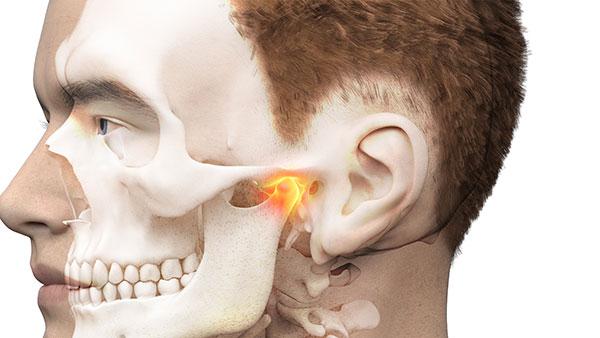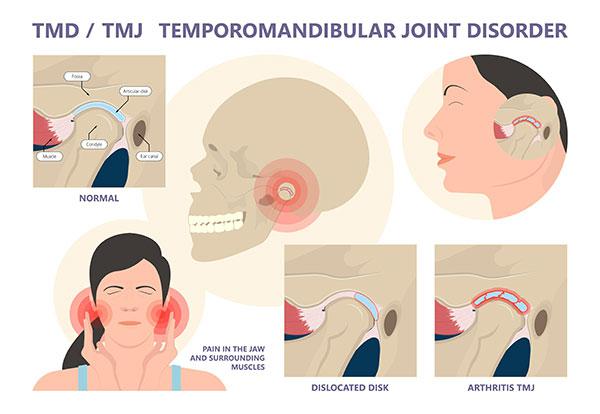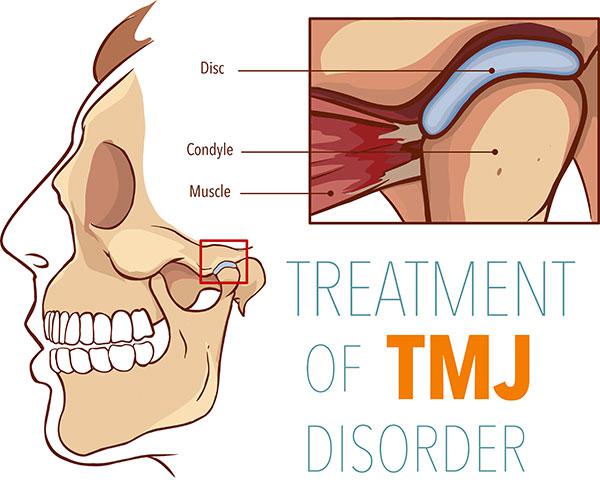 What is TMJ?
What is TMJ?
TMJ is short for the Temporomandibular joint, also known as the jaw joint. This joint connects the only mobile bone of the face, the mandible (lower jaw), to the base of the skull.
The temporomandibular joint is located just in front of the ear on both sides of the face. This joint is divided into two cavities by a soft cartilaginous disk. It provides a cushion and allows for the smooth, gliding movement of the jaw. It allows the lower jaw to open and close and move side to side, forward and back. It also protects the jaw from shock and undue forces.
The temporomandibular joint is the most complex joint in the human body. It provides attachment to various facial muscles, which allows actions such as chewing, swallowing, talking, and yawning. All these structures (jaw-joint, cartilaginous disk, muscles, ligaments, and lower jaw) must be appropriately aligned to function harmoniously. Any deviation in the proper functioning of any component of the jaw joint will lead to temporomandibular disorders.
Causes of TMJ disorders
Studies have shown that up to 25% of the population suffers from Temporomandibular disorders (TMDs), but only a tiny percentage of these individuals seek treatment. This can be attributed to a lack of awareness and ignorance. Many who report to the oral surgery clinic with TMDs have advanced stages of this disease. This is usually because they ignored early signs of TMDs and started taking them seriously only when the symptoms became prominent and often unbearable.
TMDs refer to a group of conditions affecting the orofacial region. These conditions can involve the joint or the adjoining muscles. The cause of TMDs is multifactorial, and quite often, the reason may be obscure.
The leading cause of TMDs is excessive strain on the jaw joint and muscles that control chewing, swallowing, and speech. This strain may result from parafunctional habits such as Bruxism (habitual teeth grinding and jaw clenching).
Other reasons include trauma to the jaw, head, or neck. Arthritic changes, inflammatory changes, and displacement of the jaw joint disk also lead to TMDs. Some studies have also linked malaligned teeth as a risk factor for TMDs.
Certain systemic ailments like fibromyalgia may also contribute to TMJ pain. Chronic stress, physical or emotional, can also predispose individuals to TMDs. Psychological conditions such as anxiety and depression also increase the risk of TMDs.
Now that we have listed all the possible reasons for TMDs let's take a look at some of the most common signs and symptoms of TMJ disorders. Recognizing these signs and symptoms is critical to early diagnosis, prevention, and complete treatment.
 Symptoms of TMJ disorder
Symptoms of TMJ disorder
-
The most common and first symptom of TMJ disorder is pain. The pain may be localized to the front of the ear, radiate to the face, including the lower jaw, and radiate to the neck in severe conditions.
-
Jaw soreness and discomfort, which is more severe just after waking up. The soreness and pain will lessen or get relieved as you go through your day.
-
Ear pain and a ringing sensation in the ears.
-
You may hear a clicking or a popping sound whenever you open your mouth.
-
You may experience locking of the jaw if you try to open your mouth wide.
-
You may have minimal or restricted mouth opening and limited lower jaw movement.
-
Discomfort and pain in opening and closing of the mouth.
-
Difficulty chewing and swallowing.
-
Facial pain radiating to the head, especially the temple region.
-
Teeth grinding and jaw cleaning.
-
Unusual forces and teeth grinding may lead to teeth sensitivity without oral health disease.
-
Change in the way your upper and lower teeth fit together.
 Treatment for TMJ disorder
Treatment for TMJ disorder
Treatment for TMJ disorder depends upon the cause and severity of the condition. Therefore, a proper diagnosis is made. It starts a thorough examination of the jaw joint. Your oral and maxillofacial surgeon in Phoenix, AZ, will first analyze your jaw joint by listening and palpating the joint when you open and close your mouth. They will observe the range of motion in your jaw and identify sites of pain and discomfort to understand the cause behind your TMD.
They may also order certain x-rays to evaluate your oral cavity's health and assess the status of the jaw joint. These x-rays may include OPG, CBTC scans, and MRI of the jaw joint and surrounding structure.
In some cases, TMJ arthroscopy is used. A small thin tube is inserted into the joint space through which a tiny camera is put into the jaw joint cavity. This helps them understand the anatomy shift and perform the needed treatment.
In mild cases, the treatment is conservative. The main aim is to prevent the progression of the disease. Conservative treatment of TMJ disorders includes medications, oral splints, mouthguards, and physical therapy. In some cases, your oral surgeon may also suggest counseling if the cause behind your TMJ disorder is psychological.
Surgical procedures for TMJ disorders include :
Arthrocentesis: It is a minimally invasive procedure that involves inserting a small needle into the joint. Through this needle, the jaw joint is irrigated with the help of saline. This procedure helps remove debris and inflammatory products, thus relieving symptoms of TMD.
Injections: In some cases, corticosteroids, botox, and hyaluronic acid may be injected into the joint space. This helps relieve pain associated with TMJ disorders.
Condylotomy: It increases the space of the joint and allows for complete movement of the joint.
Open-Joint surgery (Arthroplasty): This involves opening the joint under general anesthesia. The surgeon will attempt to fix the joint and the articulating disk. This is an invasive procedure and is reserved for severe TMJ disorders. It is also done in cases of Ankylosis, where the lower jaw bone fuses with the joint. In such cases, a new joint has to be created. In some cases, joint replacement surgery may have to be undertaken.
We hope this article was helpful to you. If you have any more questions or would like to schedule an appointment with Dr. Alexander Kim or Dr. Reed Day at Phoenix Oral and Facial Surgery, please contact us. Our team of excellent maxillofacial surgery professionals is here to assist you.

